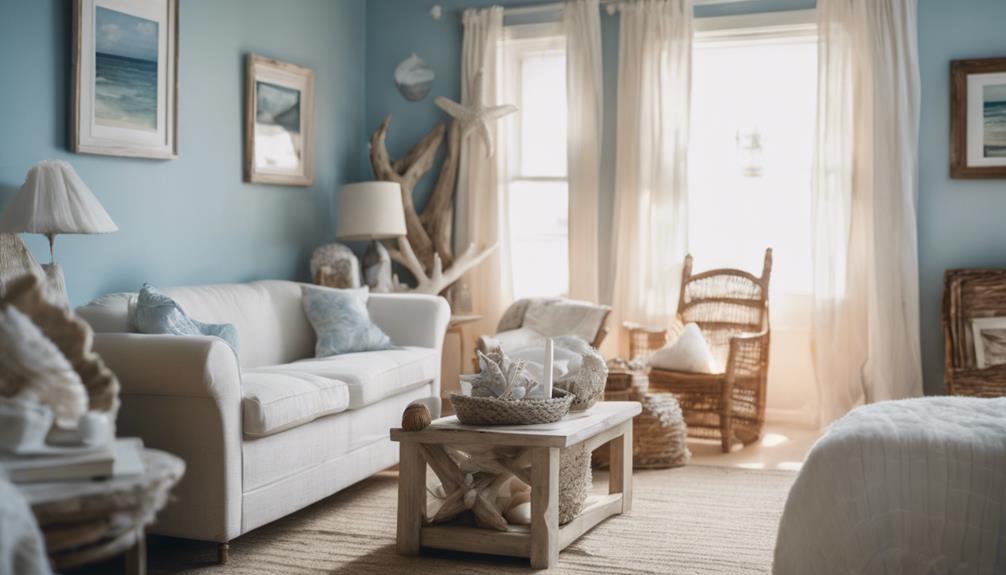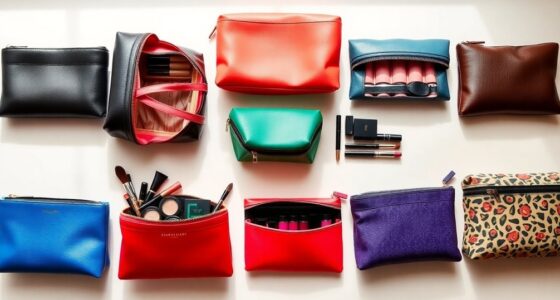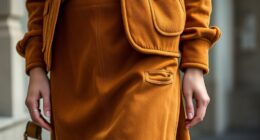In order to establish a customized skincare regimen, begin by determining your skin type – oily, dry, combination, or sensitive. Next, identify your specific skin concerns, such as acne or aging. Select essential products that are appropriate for your skin: a gentle cleanser, a targeted serum, and a moisturizer with SPF. Develop your routine by cleansing twice daily, applying serums before moisturizing, and making adjustments for seasonal changes. Stay consistent with your application and monitor how your skin reacts. Avoid common mistakes, like over-exfoliating. By understanding your skin’s needs, you will improve your routine effectively, and there is much more to explore as you perfect your approach!
Key Takeaways
- Identify your skin type (oily, dry, combination, or sensitive) through a bare-faced test after cleansing.
- Assess specific skin concerns like acne, aging, or dryness to tailor product selection.
- Choose suitable products with active ingredients based on your skin needs, such as vitamin C or hyaluronic acid.
- Build a daily routine including cleanser, toner, serum, moisturizer, and SPF for optimal skin health.
Identifying Your Skin Type
To identify your skin type, you can perform a simple bare-faced test that reveals how your skin reacts after washing and waiting for 30 minutes. Start by cleansing your face with a gentle cleanser, then let your skin breathe without applying any products.
After the 30 minutes, observe how your skin feels. If your skin looks shiny and feels greasy, you likely have oily skin. On the other hand, if it feels tight, looks flaky, or feels rough, you may have dry skin.
If your skin shows a mix of both—oily in the T-zone and dry on the cheeks—you probably have combination skin. Sensitive skin, however, might react with redness, irritation, or discomfort, indicating a need for special care.
Understanding your skin type is essential for creating an effective skincare routine. It helps you choose the right products that cater specifically to your needs, ultimately leading to a personalized skincare routine that promotes healthy, balanced skin.
Assessing Skin Concerns
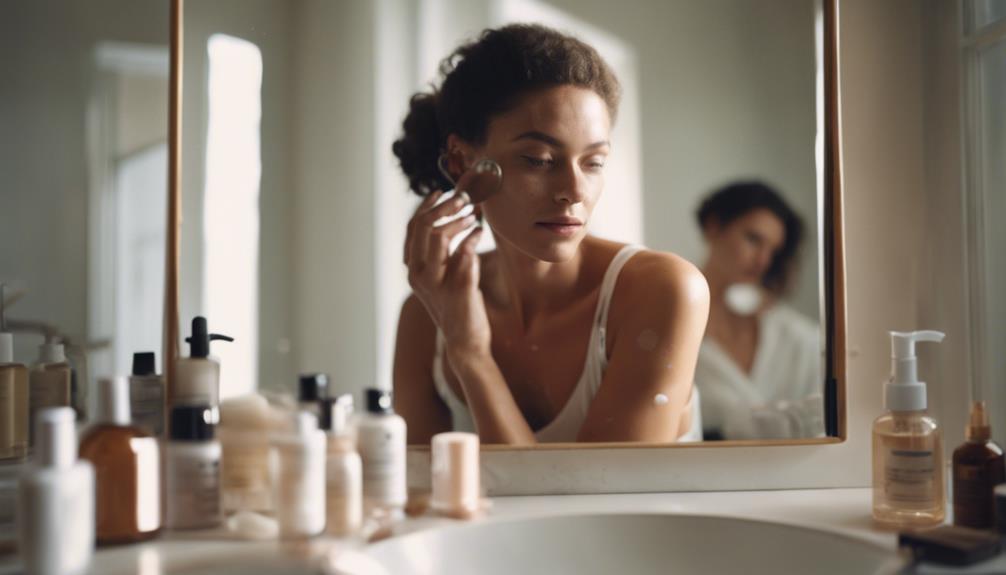
To effectively assess your skin concerns, start by identifying common issues like acne, aging, or dryness.
Next, pinpoint your specific needs to tailor your product selection accordingly.
This focused approach helps you address your skin's unique challenges for ideal results.
Common Skin Issues
Common skin issues can greatly impact your confidence and daily routine, often requiring careful assessment to determine the best approach for treatment.
One of the most prevalent concerns is acne, affecting about 85% of people at some point due to excess oil and clogged pores.
Additionally, signs of aging, such as fine lines and wrinkles, usually start appearing in your late 20s or early 30s as collagen production decreases.
Hyperpigmentation is another common issue, impacting around 74% of women; it can arise from sun exposure, hormonal changes, or skin injuries, leading to uneven skin tone.
Dehydration often manifests as tightness, flakiness, or dullness, exacerbated by environmental factors and harsh products that strip moisture away.
If you have sensitive skin, you may notice heightened reactions to various ingredients or environmental factors, affecting nearly 50% of individuals. This requires a focus on gentle formulations to prevent irritation.
Understanding these common skin issues will help you in creating a personalized skincare routine that targets your specific concerns effectively.
Identifying Specific Needs
Evaluating your skin concerns is essential for tailoring a skincare routine that effectively addresses your unique needs.
Start by determining your skin type—normal, oily, dry, combination, or sensitive. You can do this with a simple bare-faced test. Cleanse your face and wait 30 minutes to see how your skin behaves.
Next, identify specific skin concerns like acne, aging, pigmentation, or moisture loss. These factors will guide your choice of active ingredients in your personalized skincare routine. Consider using a skin analysis questionnaire to assess your natural skin behavior and the improvements you desire.
Pay attention to how your skin reacts to different products and environmental factors. This can indicate whether you need to make adjustments to your routine.
Regularly document any changes in your skin condition, tracking improvements and pinpointing areas that might need additional focus or different products over time.
Tailoring Product Selection
Once you've identified your specific skin needs, it's time to select products that directly address those concerns. Start by evaluating your skin type and concerns—whether it's oily, dry, or sensitive—so you can choose products that work for you. For targeted treatments, look for active ingredients that align with your skin issues.
Here are some key considerations for tailoring your product selection:
- Active Ingredients: Choose serums with ingredients like Vitamin C for brightening or niacinamide for improved texture.
- Moisturizers: Use lightweight, oil-free moisturizers for oily skin and richer, hydrating formulas for dry skin to maintain hydration.
Essential Skincare Products
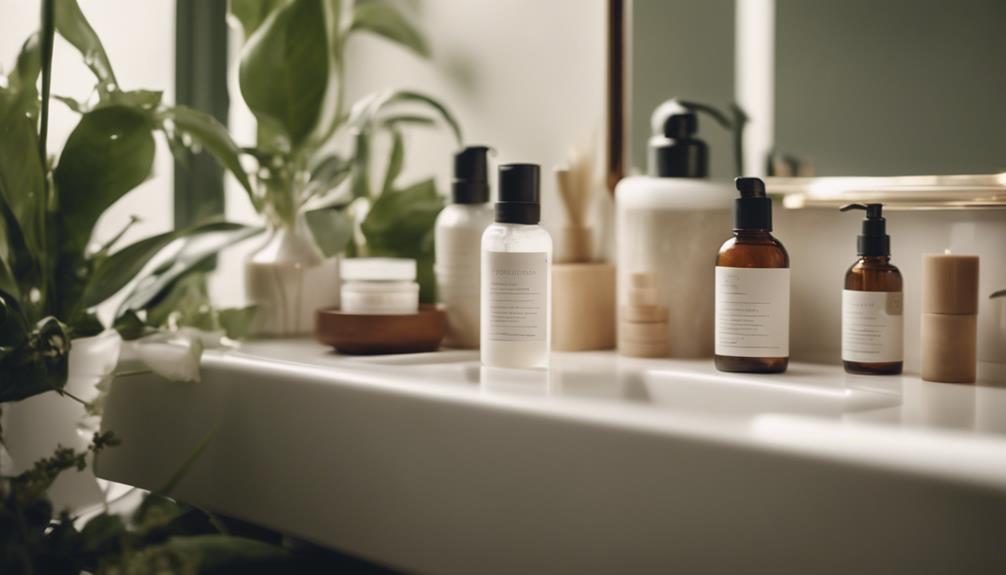
To achieve healthy skin, you'll want to incorporate essential skincare products into your daily routine. Start with a cleanser tailored to your skin type. If you have oily skin, opt for a gel-based cleanser; for dry skin, choose a cream-based one; and for sensitive skin, look for gentle formulas. This initial step helps remove impurities effectively.
Next, consider adding a targeted serum. Depending on your skin concerns, you might select a serum with vitamin C for brightening, hyaluronic acid for hydration, or retinol for anti-aging. These serums deliver potent ingredients that can greatly enhance your routine.
After cleansing and applying serum, it's vital to add a moisturizer. Choose a lightweight, oil-free formula if you have oily skin, while richer creams work best for dry skin. This hydrates your skin and locks in moisture.
Building Your Daily Routine
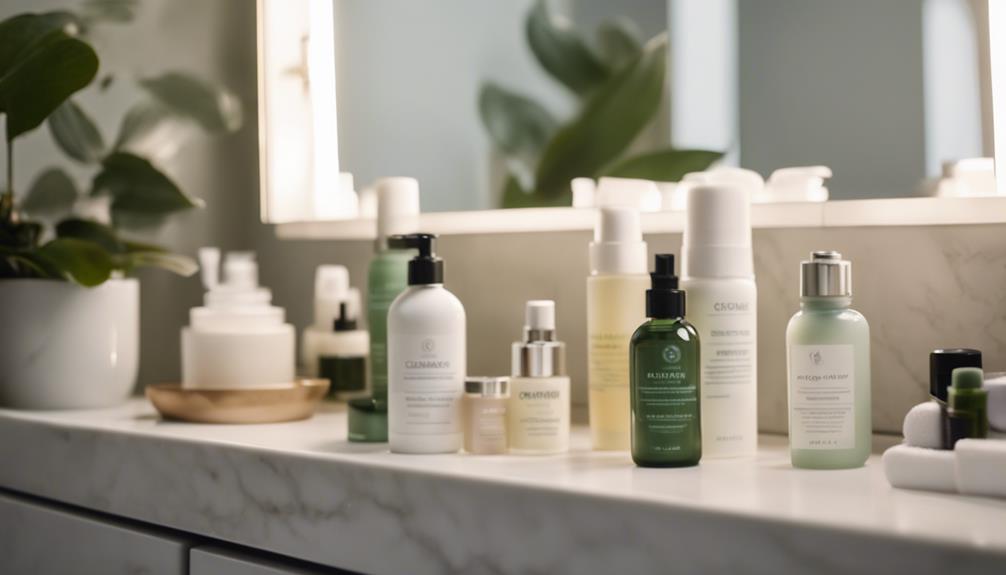
Building a daily skincare routine starts with a gentle cleanser tailored to your skin type, ensuring you effectively remove impurities twice a day. This sets the stage for the rest of your products.
After cleansing, consider adding a toner to balance your skin's pH and boost hydration. Choose a toner that aligns with your specific needs, whether it's hydrating for dry skin or exfoliating for oily skin.
Next, incorporate a targeted serum that addresses your unique concerns, like vitamin C for brightening or hyaluronic acid for extra hydration. Apply this before your moisturizer to maximize its benefits.
Your moisturizer should match your skin type and lock in hydration—look for ingredients like glycerin for dry skin or lightweight, non-comedogenic formulas for oily skin.
Finally, finish your morning routine with a broad-spectrum SPF of at least 30. This protects your skin from harmful UV damage, making it an essential step in your personalized skincare routine.
- Choose a gentle cleanser that suits your skin type.
- Select a targeted serum for your specific skin concerns.
Adjusting for Seasonal Changes

As the seasons change, your skincare routine should adapt to keep your skin healthy and balanced.
In summer, you'll want to choose lightweight products, while winter calls for richer moisturizers to combat dryness.
Pay attention to how your skin reacts, and adjust your routine accordingly throughout the year.
Summer Product Recommendations
Embrace summer by revamping your skincare routine with lightweight, oil-free products that keep your complexion rejuvenated and clear. The heat and humidity can lead to excess oil and breakouts, so it's crucial to choose the right items.
Start with a gentle cleanser to remove sweat and sunscreen without stripping your skin. Look for gel-based or hydrating serums that feature hyaluronic acid to maintain hydration without weighing you down.
Don't forget to apply broad-spectrum sunscreen with at least SPF 30 daily to shield your skin from harmful UV rays. Incorporating exfoliating products with glycolic acid can also help manage oil buildup, leaving your skin looking clearer and brighter.
Here are some product recommendations to reflect upon:
- Oil-free moisturizers: Lightweight formulas that hydrate without clogging pores.
- Hydrating serums: Gel-based options infused with hyaluronic acid for a revitalizing feel.
With these summer skincare essentials, you'll be ready to enjoy the sunshine while keeping your skin healthy and glowing!
Winter Hydration Strategies
With summer's light, rejuvenating products behind you, it's time to focus on effective winter hydration strategies that keep your skin nourished and protected against the harsh cold.
Start by switching to richer, cream-based moisturizers that contain ceramides and hyaluronic acid. These ingredients are vital for combating dryness and locking in moisture during the chilly months.
Next, adjust your cleansing routine. Use a gentle, hydrating cleanser to avoid stripping your skin of essential oils. After washing, make sure to apply your moisturizer immediately to maximize hydration.
To further prevent water loss, consider adding an occlusive product, like petroleum jelly or shea butter, as the final step in your skincare routine. This creates a barrier that seals in moisture.
Additionally, incorporate a humidifier in your living space to maintain ideal humidity levels, which can help keep your skin from becoming excessively dry.
Finally, limit hot showers and baths; instead, opt for lukewarm water to protect your skin's natural oils.
Transitioning Between Seasons
Shifting between seasons requires adjusting your skincare routine to meet the changing needs of your skin. Each season brings its own challenges, and being proactive guarantees you maintain healthy, glowing skin year-round.
Summer: Focus on lightweight products that are oil-free to combat excess oil and breakouts. Don't forget your SPF!
Winter: Switch to rich moisturizers loaded with hydrating ingredients like hyaluronic acid and ceramides to lock in moisture and fight dryness.
Spring: Choose allergy-friendly formulations, especially if you have sensitive skin, to address any seasonal sensitivities.
As the seasons change, regularly assess how your skin responds. You might notice shifts in oiliness, dryness, or sensitivity that warrant adjustments.
For instance, as fall approaches, incorporating nourishing treatments like facial oils can enhance hydration and protect your skin barrier.
Avoiding Common Mistakes
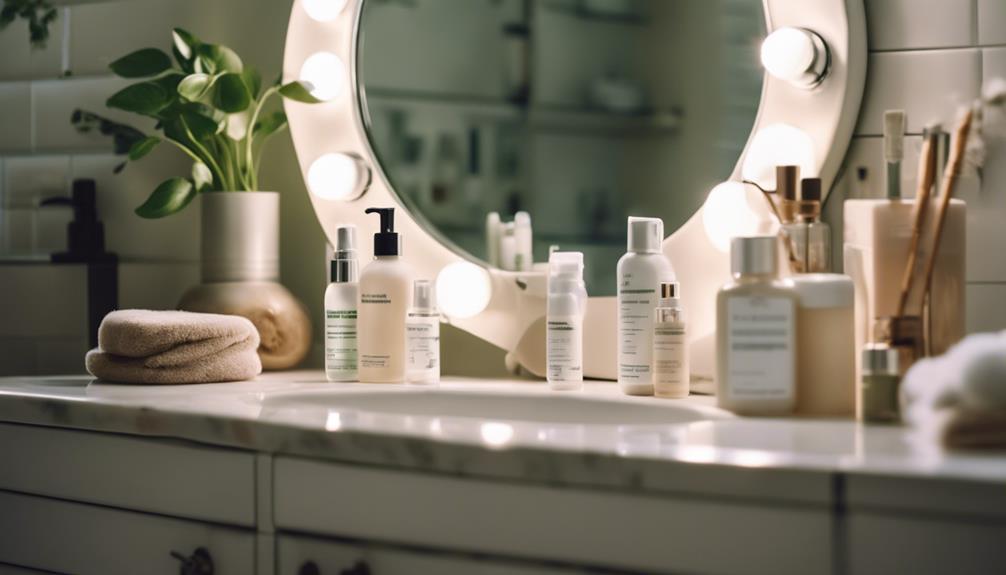
Avoiding common mistakes in your skincare routine can make a significant difference in achieving healthy, radiant skin. One major pitfall is over-exfoliating. Stick to exfoliating once or twice a week, depending on your skin type, to prevent irritation and damage to your skin barrier.
Another critical error is skipping SPF; daily application of at least SPF 30 is essential to protect your skin from UV damage and premature aging.
When it comes to active ingredients, less is often more. Using too many potent products at once can lead to irritation. Introduce new products one at a time and monitor how your skin reacts.
Don't forget about other areas, like your neck and décolletage; neglecting these zones can result in uneven skin tone and signs of aging.
Lastly, always conduct a patch test on a small area before fully incorporating new products into your routine. This step can help you avoid unexpected allergic reactions or irritations, ensuring your personalized skincare approach is safe and effective.
Importance of Consistency
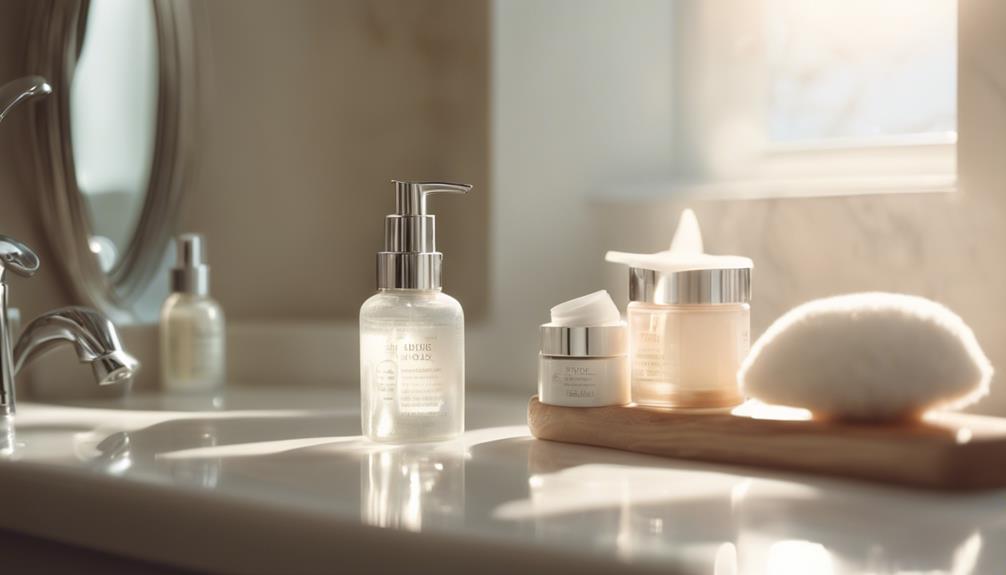
Consistency in your skincare routine is key to revealing your skin's full potential and seeing the long-term benefits of your chosen products.
When you apply active ingredients like retinol or vitamin C regularly, you allow your skin to adjust and respond effectively, leading to visible improvements in texture and tone over time. Skipping steps can hinder your progress, as each product plays a crucial role in achieving overall skin health and addressing specific concerns.
To truly appreciate the importance of consistency, consider these points:
- Regular application: Stick to your routine daily to maximize the benefits of your active ingredients.
- Track your progress: Documenting changes in your skin helps you see improvements and reinforces the need for consistency.
Targeted Treatments and Masks
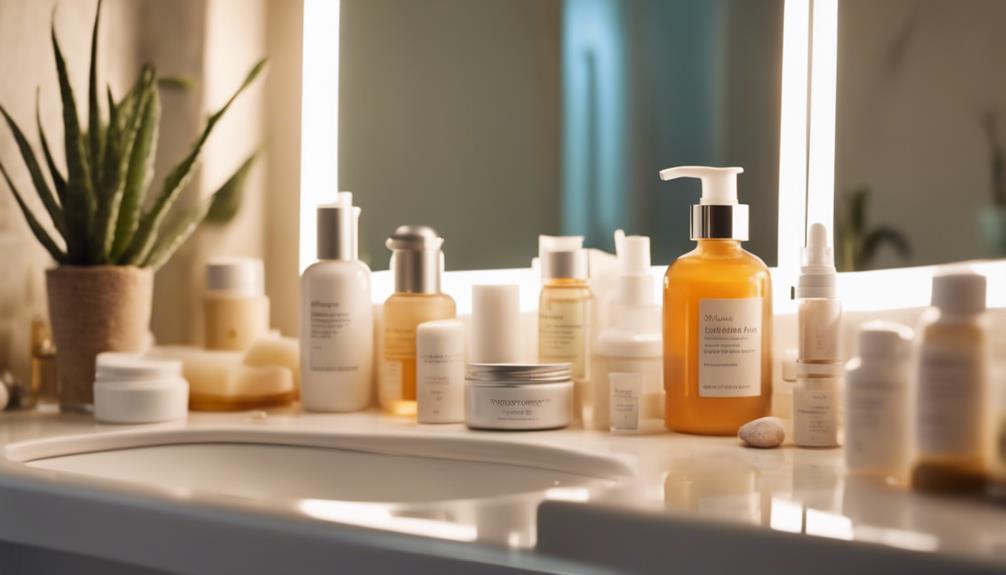
Targeted treatments and masks can elevate your skincare routine by addressing specific concerns and enhancing overall skin health. By incorporating active ingredients, you can tackle issues like dullness, fine lines, or acne. For best results, apply serums after cleansing and before moisturizing.
Here's a quick reference table to help you choose the right treatment:
| Skin Concern | Recommended Treatment | Key Active Ingredient |
|---|---|---|
| Dullness | Hydrating mask | Hyaluronic acid |
| Acne | Niacinamide serum | Niacinamide |
| Rough texture | Chemical exfoliant | Glycolic acid |
Incorporate chemical exfoliants like glycolic or salicylic acid weekly to promote cell turnover and improve skin texture. It's essential to start with lower concentrations to avoid irritation. Always perform a patch test with new treatments or masks, especially if you're trying potent active ingredients, to minimize the risk of adverse reactions. Remember, targeted treatments can provide deep hydration and enhance your skin's overall appearance when used consistently and correctly.
Seeking Professional Guidance
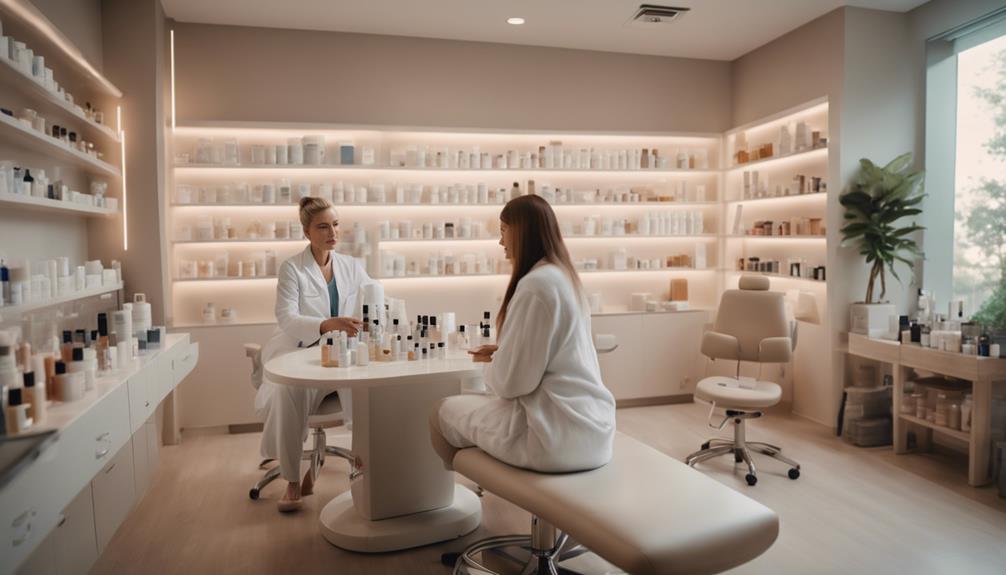
Consulting a dermatologist can be a game-changer for your skincare routine, as they provide personalized recommendations tailored to your unique skin type and concerns.
A skincare professional can conduct an in-depth skin analysis, pinpointing issues that over-the-counter products might miss. This guarantees you're addressing the root causes of any skin problems.
Here are a few benefits of seeking professional guidance:
- Customized Active Ingredients: Dermatologists suggest effective active ingredients, like retinoids for aging or benzoyl peroxide for acne, based on your skin's condition.
- Minimized Adverse Reactions: They help you choose products that suit your skin type, reducing the risk of irritation and adverse reactions.
What Are the Benefits of Personalizing a Skincare Routine?
Personalized skincare tips can greatly benefit your skincare routine. Tailoring your routine to your specific skin type and concerns can lead to more effective results. By using products and techniques that are personalized to your needs, you can achieve clearer, healthier skin and address any specific issues you may be facing.
Conclusion
Crafting your perfect skincare routine doesn't have to be complicated.
By pinpointing your skin type and addressing your specific concerns, you can build a balanced regimen that brings out your best glow.
Remember, consistency is key—don't skip your steps!
Stay savvy and steer clear of common pitfalls.
As you embrace your skincare journey, keep experimenting and adjusting to discover what truly works for you.
With patience and persistence, you'll reveal radiant, rejuvenated skin!

